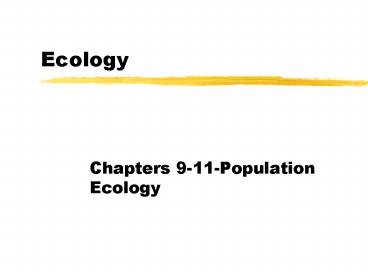Ecology - PowerPoint PPT Presentation
1 / 33
Title:
Ecology
Description:
Community (Community ecology) Interacting group of species inhabiting same area ... Population ecology is the science that describes how and why populations change ... – PowerPoint PPT presentation
Number of Views:18
Avg rating:3.0/5.0
Title: Ecology
1
Ecology
- Chapters 9-11-Population Ecology
2
What is ecology
- Study of interactions of organisms with one
another and their physical environment - How these interactions determine the distribution
and abundance of organisms
3
Levels of ecology
- Population (Population ecology)
- Interbreeding group of individuals
- Community (Community ecology)
- Interacting group of species inhabiting same area
- Ecosystem (Ecosystem ecology)
- Community plus nonliving parts of environment
4
Populations
- A population is a group of interbreeding
individuals of the same species - Populations may stay the same, increase, or
decrease - Population ecology is the science that describes
how and why populations change
5
Density Distribution
- Number of individuals in some specified area of
habitat - Crude density information is more useful if
combined with distribution data
clumped
nearly uniform
Figure 45.2 Page 808
random
6
Determining Population Size
- Direct counts are most accurate but seldom
feasible - Can sample an area, then extrapolate
- Capture-recapture method is used for mobile
species
7
Population growth
- Populations may grow or decline
- Unrestrained growth or decline is exponential
- Results in a J-shaped curve plotting numbers of
individuals versus time - Exponential growth is proportional to number of
individuals present in population
8
Exponential Growth Equation
- G rN
- G is population growth per unit time
- r is net reproduction per individual per unit
time - N is population size
9
Population Growth
net population growth rate per individual per
unit time
population growth per unit time
number of individuals
X
10
Growth rate
- Growth is the number of births - number of deaths
in a population - Birth rate is number of births/1000 individuals
- Death rate is number of deaths/1000 individuals
11
Population Growth
- Populations grow when birth rategtdeath rate, stay
the same when equal, decline when birth
rateltdeath rate - r is the maximum growth rate
12
(No Transcript)
13
Limits to exponential growth
- Populations cannot grow indefinitely
- Resources (space, food, light, etc) limit growth
- Logistic growth model (S-shaped curve) describes
limited growth
14
Logistic Growth Equation
- G rmax N (K-N/K)
- G population growth per unit time
- rmax maximum population growth rate per unit
time - N number of individuals
- K carrying capacity
15
Exponential Growth vs. Logistic Growth
16
Role of movement of individuals
- In addition to births and deaths
- Emigration removes individuals and immigration
adds individuals to a population - Change in population is births plus immigrants
minus deaths plus emigrants
17
Density-dependent and independent factors
- Some factors that affect birth and death rates
are dependent on the size of the population
(density-dependent factors) - Larger populations may mean less food/individual,
fewer resources for survival or reproduction - Other factors that may affect these rates may be
independent of population size (fire or hurricane)
18
Natural populations
- Studies of natural populations show that
exponential growth can occur when populations are
small and resources abundant - But all populations stop growing when resources
run out - Sometimes populations overshoot carrying
capacity, begin fluctuating around the carrying
capacity
19
(No Transcript)
20
Life-history traits of species
- Each species has its own unique capacity to grow
rapidly - Some species can experience rapid exponential
growth - R-selected species, weeds, cockroaches, many
insects - Other species grow very slowly
- K-selected species, elephants, large trees
- Most species show aspects of both types
21
Life-history traits
- Mortality curves show how quickly individuals die
- Type I (low juvenile mortality, high adult
mortality)-humans - Type II (constant mortality)-birds
- Type III (high juvenile mortality, low adult
mortality)-insects
22
(No Transcript)
23
Population Age Structure
- Divide population into age categories
- Populations reproductive base includes members
of the reproductive and pre-reproductive age
categories
24
Age structure of a population
- Fraction of individuals of different ages
- Each group born at the same time forms a cohort
- Age structure related to growth rate
- Pyramid shape is rapid growth, many young (India)
- Diamond shape is slower growth (USA)
- Rectangular shape is zero growth (Sweden)
25
(No Transcript)
26
(No Transcript)
27
Demography (Human populations)
- Annual rate of increase percentage change in a
population - Completed family size average number of
children born to each family that reach
reproductive age - Replacement reproduction same number of
children as their parents (2.1) - Population momentum-due to many young not yet
reproducing
28
(No Transcript)
29
(No Transcript)
30
Demographic Transition Model
- Based on historical data from western Europe
- Postulates that as countries become
industrialized, first death rates drop, then
birth rates drop
31
Demographic Transition Model
Stage 1 Preindustrial
Stage 2 Transitional
Stage 3 Industrial
Stage 4 Postindustrial
relative population size
births
deaths
low
increasing
very high
decreasing
low
zero
negative
Figure 45.16 Page 822
32
(No Transcript)
33
Earths carrying capacity
- Have humans exceeded the carrying capacity of the
earth? - 6 billion and rising
- Use 40 of all the energy of the earth for
ourselves - Inability to feed everyone
- Reliance on unsustainable energy reserves (oil,
coal, and gas) - Extinction of wild species of plants and animals

